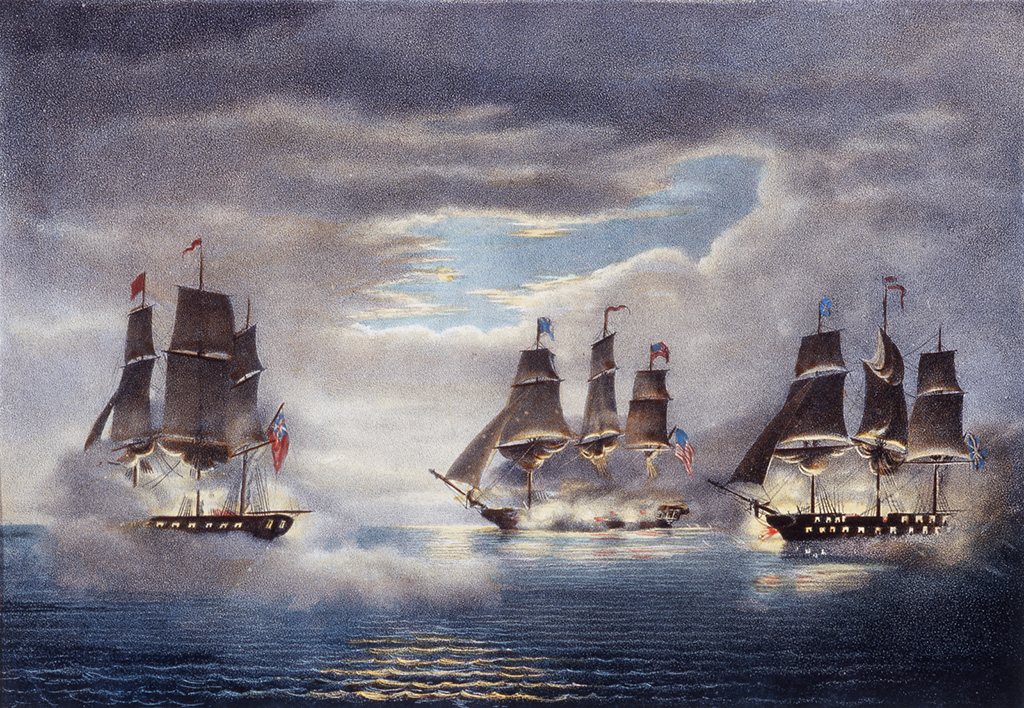The world of the museum curator or historian is akin to that of a detective’s world. Just like detectives, curators and historians spend their days digging into the past, gathering clues, and, finally, assembling the clues into a story or solution that solves the original mystery – or so the curator or historian hopes. It is often thought that few mysteries remain pertaining to USS Constitution‘s history, for “America’s Ship of State” has been with us for 220 years. Surely all the mysteries have been discovered and solved, right?
Actually, no. The 203rd anniversary of “Old Ironsides'” victorious battle against HMS Cyane and HMS Levant, on February 20, 1815, provides an opportunity to solve one little mystery in this storied ship’s long life. Let’s begin with a quick re-cap of the battle.
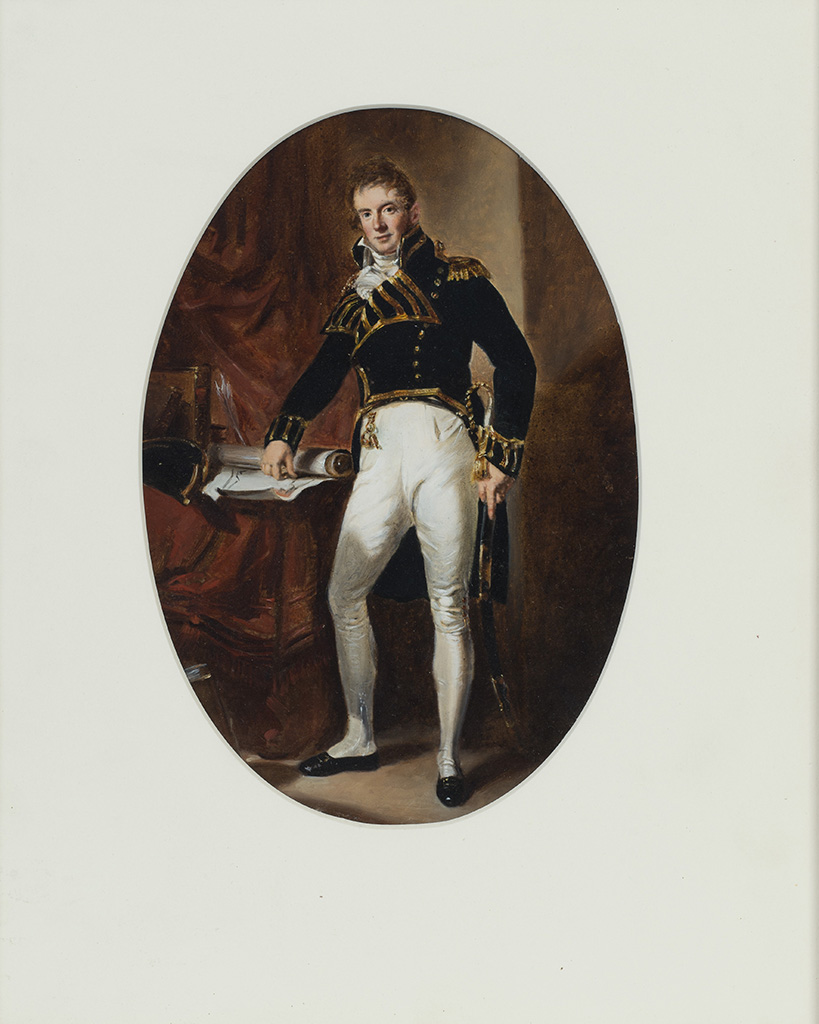

Charles Stewart was the third War of 1812 commanding officer of Constitution. He and his crew were anxious to get into the action as peace negotiations between the United States and Great Britain were underway.
“At one, discovered a sail two points on the larboard bow…made sail in chase…discovered another sail ahead…” [USS Constitution‘s logbook entry as reprinted in Official Letters of the Military and Naval Officers…During the War with Great Britain, 1823]
And thus began Constitution‘s last battle of the War of 1812 on February 20, 1815. It took five hours before the warships were close enough for action. Constitution maintained the windward advantage over the opponents, much to their consternation. For Constitution‘s log noted:
“…they made all sail close hauled by the wind, in hopes of getting to the windward of us; at 55 minutes past 5, finding themselves disappointed in their object, and we were closing with them fast, they shortened sail, and formed on a line of wind, about half a cable’s length [approximately 360 feet] from each other. At 6 P.M. having them under command of our battery, hoisted our colours, which was answered by both ships hoisting English ensigns.” [Official Letters…]
“Old Ironsides” was about to engage the frigate HMS Cyane (rated at 22 guns, carrying 34 the day of the battle) and the sloop of war HMS Levant (rated at 18 guns, but carrying 21 guns).


Broadsides were exchanged for the first fifteen minutes, but then slackened. The crew of Constitution waited for the “great column of smoke collected under our lee” to clear so that they could ascertain the locations of the Royal Navy warships.
“…we [Constitution] found ourselves abreast of the headmost ship [Levant], the sternmost ship [Cyane] luffing up for our larboard quarter; we poured a broadside into [Levant], and then braced aback our main and mizen topsails, and backed astern under cover of smoke, abreast [Cyane], when the action was continued with spirit and considerable effect, until 35 minutes past 6, when [Cyane’s] fire again slackened, and we discovered [Levant] bearing up; filled our topsails, shot ahead, and gave [Levant] two stern rakes…” [Official Letters…]
Constitution swung back to Cyane, which was maneuvering for position; “Old Ironsides” raked the British ship which returned a broadside into the American’s starboard bow. Constitution prepared to return fire with a starboard broadside when Cyane “struck her colours, fired a lee gun and yielded.” Constitution had captured HMS Cyane, captained by Gordon Falcon at 50 minutes past 6 p.m. About one hour later, after taking physical possession of Cyane, Constitution “filled away after…[Levant], which was still in sight to leeward.” Thirty minutes of sailing brought “Old Ironsides” within sight of Levant which was:
“…standing towards us…with topgallant sails set and colours flying….[Constitution] ranged close alongside to windward of her… and exchanged broadsides; wore immediately under her stern and raked with a broadside. [Levant] then crowded all sail and endeavoured to escape by running; [Constitution]…set spanker and flying jib in chase. At half past 9, commenced firing on her from our starboard bow chaser; gave her several shot, which cut her spars and rigging considerably. At 10 P.M. finding they could not escape, fired a gun, struck her colours and yielded.” [Official Letters…]
HMS Levant was captained by George Douglass. Charles Stewart and the officers and crew of USS Constitution were once again victorious in the waning days of the War of 1812.
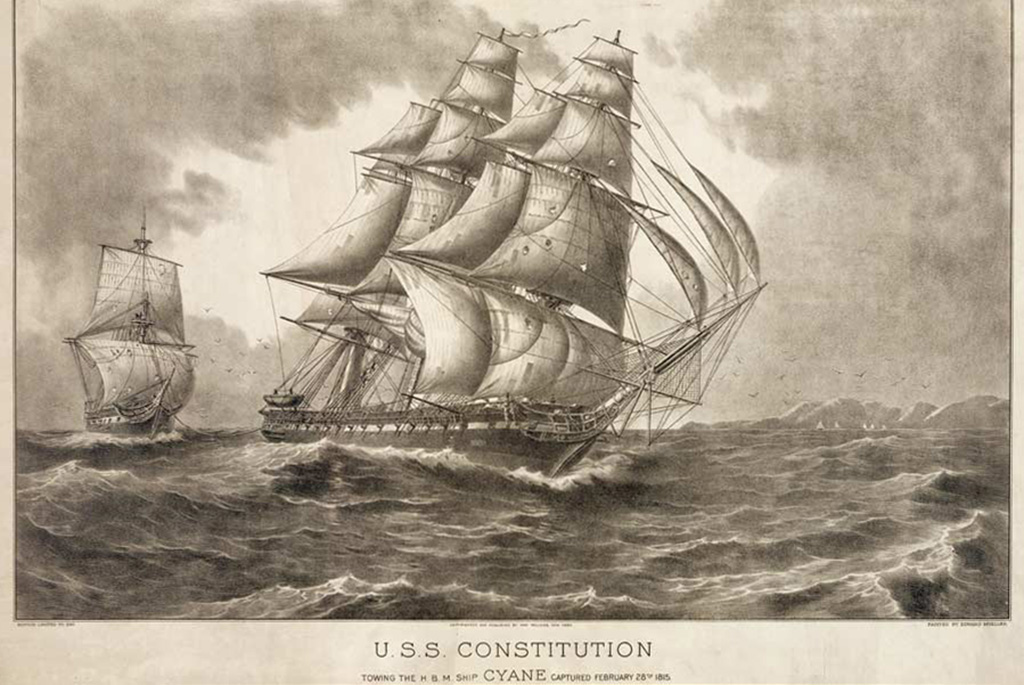

Several weeks later, while in the neutral harbor of Porto Praia, Cape Verde, the three vessels were nearly trapped by a British squadron. Stewart, fearing the Britons would not honor the neutrality of the port, made a hasty exit with Constitution, Cyane and Levant. Once underway, “Old Ironsides”, larger and faster than the two smaller captured vessels, began to out sail her prizes. Stewart ordered Cyane and its prize crew to return to Porto Praia and safety, believing that Constitution and Levant could out run the British squadron. Unfortunately Levant and her American prize crew were captured, but Cyane was successful in her escape. Constitution, too, escaped and returned to New York and a hero’s welcome on May 16, 1815. Even though the War of 1812 was officially over with the ratification of the Treaty of Ghent on February 17th, Constitution‘s last battle, which took place three days after the ratification, was considered a legitimate capture.
The Mystery
HMS Cyane became USS Cyane in 1819, after being purchased by the U.S. Navy. Her American naval career was not long: between 1819 and 1821, she served in the anti-slavery patrol off the west coast of Africa and in the West Indies and she was a member of the Mediterranean and Brazil squadrons between 1824 and 1827. Cyane was laid up at the Philadelphia Navy Yard after her final cruise; she sank in 1835 and was broken up the following year.
Before HMS/USS Cyane was destroyed, her billethead, a richly carved, sinuous dragon figure, was removed and “preserved at the Philadelphia Navy Yard,” according to Benson J. Lossing, who published an image of the dragon carving in The Pictorial Field-book of the War of 1812 (1869).
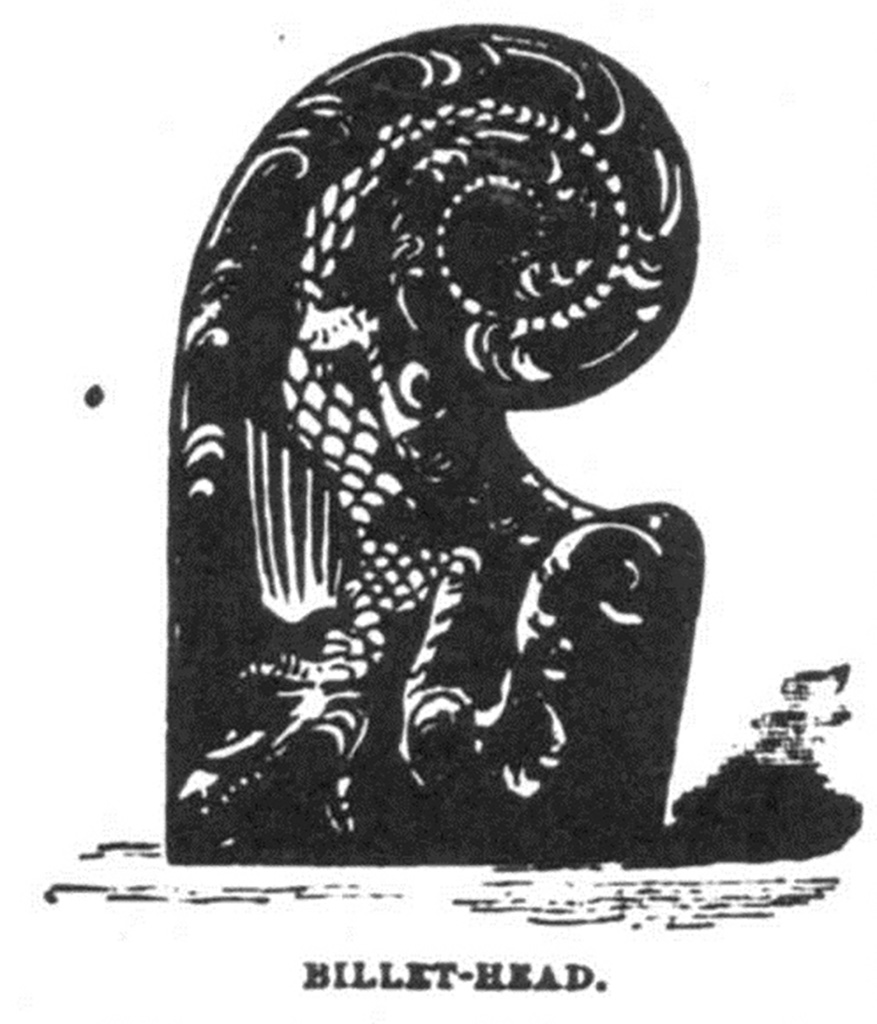

USS Constitution, too, ended up at the Philadelphia Navy Yard, where she was laid up for an on-again-off-again rebuilding between 1872 and 1877. In 1876, Constitution‘s 1820 billethead, displayed in the Charlestown Navy Yard and incorrectly identified as her War of 1812 bow decoration, was sent to Philadelphia to be reattached to the ship. The 1820 billethead was too rotten to be used and we presume it was discarded.
In 1886, Cyane‘s billethead was sent to the United States Naval Academy, Annapolis, Maryland.
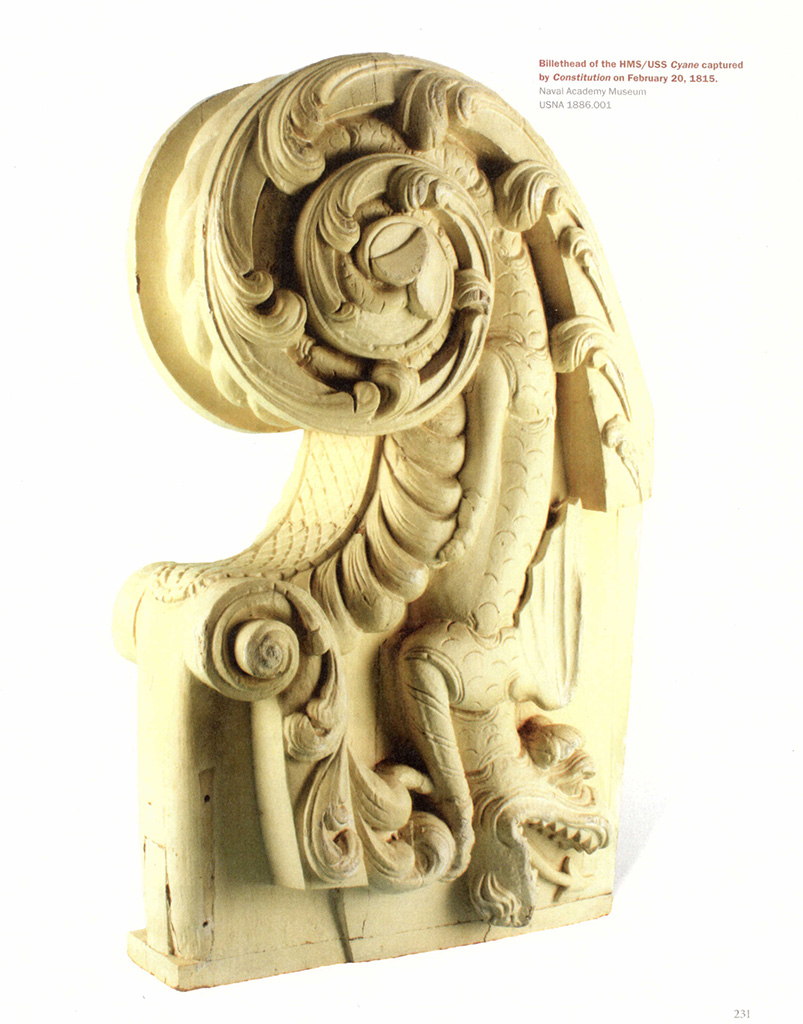

By 1900, that Royal Navy carving was mistakenly believed to be USS Constitution‘s War of 1812 billethead. Ira N. Hollis, a graduate of the U.S. Naval Academy, became a professor of engineering for Harvard University and in that year published the first, comprehensive history of “Old Ironsides”.
Titled The Frigate Constitution: The Central Figure of the Navy Under Sail (1900), Hollis included a photograph of “Figure-heads of the Constitution”. The photo shows the second Andrew Jackson figurehead and the Cyane dragon billethead (see photo below).
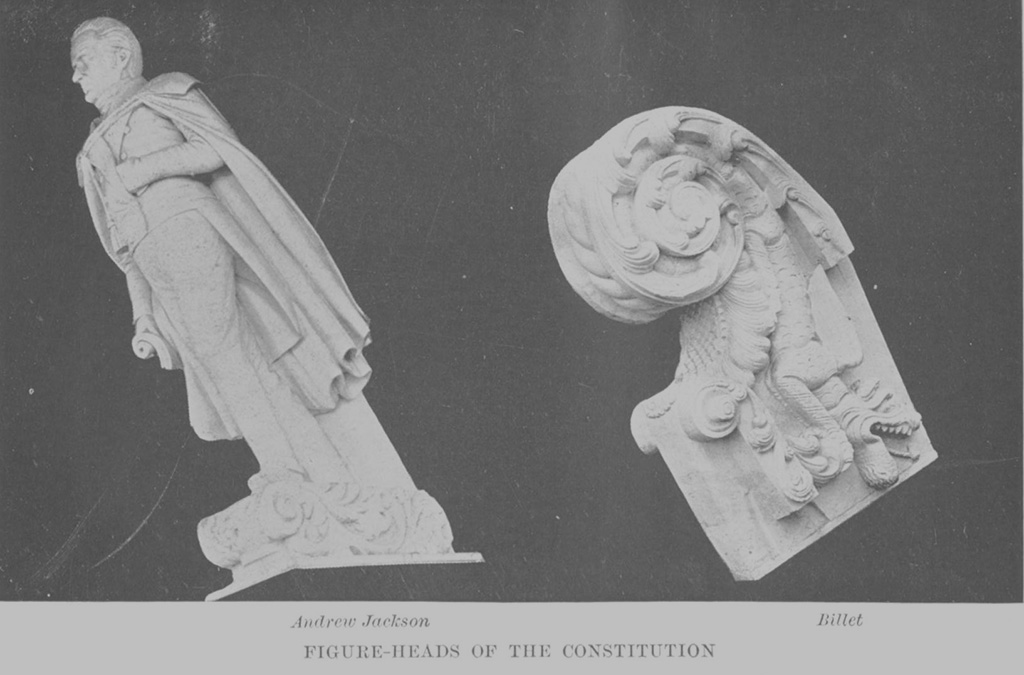

How did the (acknowledged) billethead from HMS/USS Cyane become confused with Constitution‘s history? How did Hollis make this mistake? Sadly, we don’t know because the research for his book doesn’t survive. Because of his book, though, it appears that Hollis became the perpetrator of the inaccuracy, thereby leading every Constitution historian, for the next quarter of a century (or more), down the wrong path. His book was considered definitive and his credibility, as a Naval Academy graduate and university professor, was strong – who was there to argue with his research and conclusions?
USS Constitution’s Dragon Billethead
USS Constitution‘s 1906-1907 restoration was under the purview of Naval Constructor Elliot Snow. Although it is not known for certain, it is presumed that Snow was familiar with Hollis’ book and research. The Hollis photo of the mis-identified Cyane billethead could have been the first bit of evidence that Snow used to decide upon a new, dragon billethead for “Old Ironsides”. The second bit of evidence could have come when Snow examined the 1812 Constitution model made for Capt. Isaac Hull by his crew. The model appears to depict a dragon or alligator on the ship’s trailboards (see photo below).
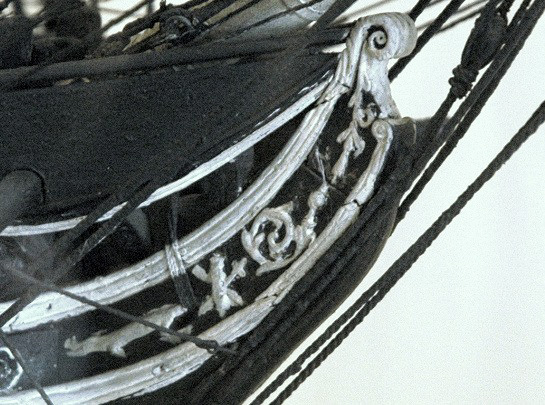

Research conducted by Hollis and Snow appeared to strongly indicate that some sort of a dragon graced Constitution‘s bow in the War of 1812. And so, a dragon was carved for the ship.
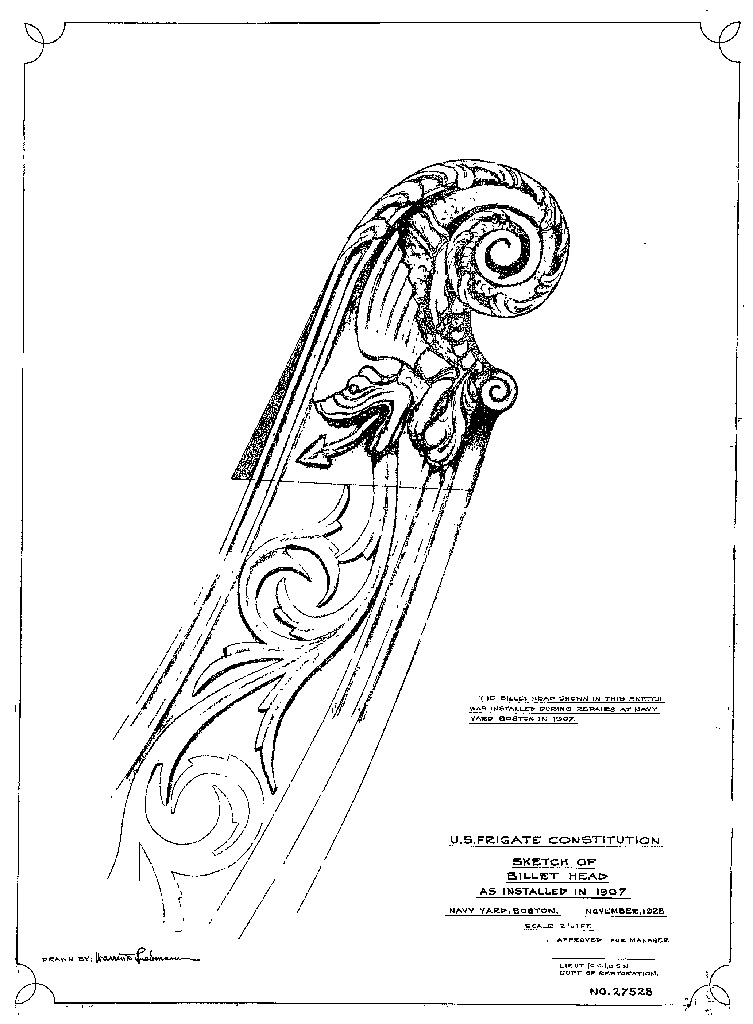

The mystery of why USS Constitution was given a dragon billethead for her 1906 restoration appears to have been solved! But, the detective work continues…
Two early 20th century photographs further compound the error of “Old Ironsides” and a dragon billethead. One of the two photos (see below) shows the Cyane head with a bronze plaque that reads:
“Billet Head worn by the Frigate ‘Constitution’ in the War of 1812./’Her white wings flying never from her foes.'” [Quote is from Lord Byron’s 1814 poem “The Corsair.”]
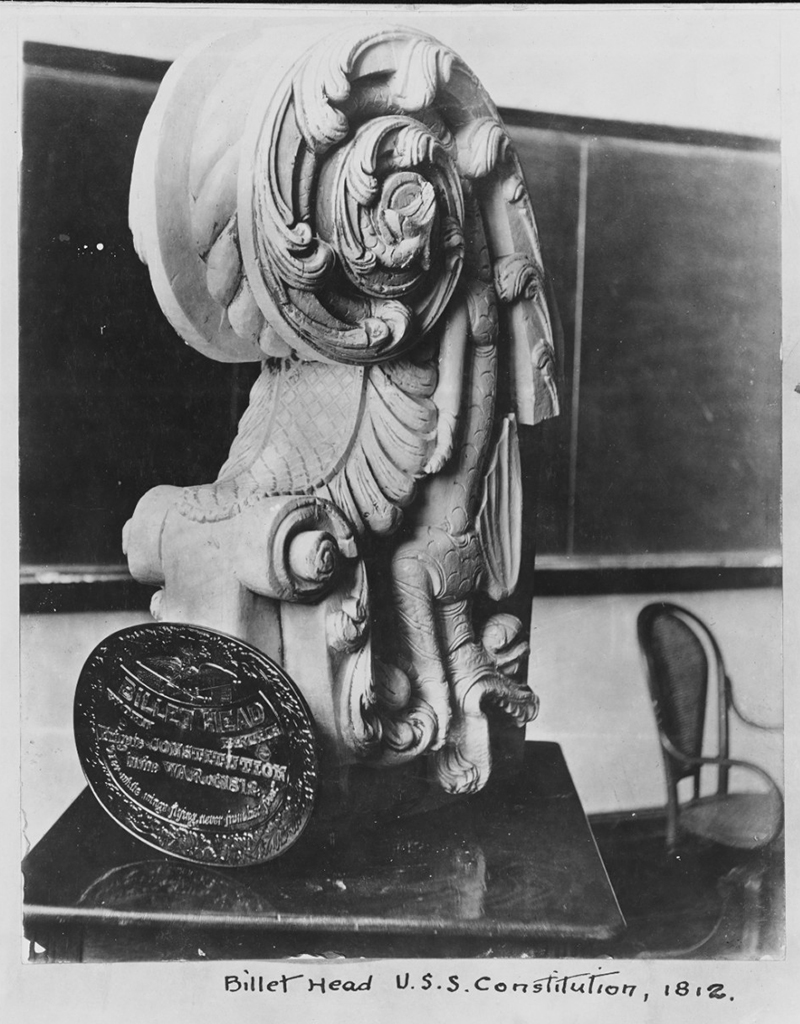

The bronze plaque was sent to the Naval Academy in 1921 when the Boston Naval Library & Institute (B.N.L.&I.), a collecting repository of U.S. Navy history located in the Boston (Charlestown) Navy Yard, was disbanded. To what was the bronze plaque originally attached when in the B.N.L.&I. collection? Unfortunately, we do not know. The accession records of the objects transferred from Boston were not sent to the Academy.
An identical bronze plaque was “restored” to the U.S. Navy in 1926. According to The Independent of St. Petersburg, Florida:
“BILLET HEAD OF FAMOUS FRIGATE ‘CONSTITUTION’ RESTORED TO NAVY
Boston, Feb. 23. – (AP) – The billethead of the United States frigate Constitution has been returned to its rightful owner – the United States navy. The Veteran Fusilliers association presented the relic to Rear Admiral Philip Andrews, commandant of the Charlestown navy yard, at exercises yesterday. The Constitution is berthed here while school children of the country are raising funds to preserve her from disintegration. The billet head [actually a bronze plaque], which bears the inscription ‘Her white wings flying never from her foes,’ was recovered from a rubbish heap years ago by Sergeant ClarenceWoodbury of the Fusilliers.” [February 23, 1926]
Where does all this research lead us?
We now know why Elliot Snow had a dragon billethead carved for Constitution‘s 1906 restoration – no one had ever made the connection between Snow’s dragon billethead and the mis-identified Cyane billethead. We know, too, where the bronze plaques originated, even if we don’t, yet, know why or for what they were created. The new mystery is to try and find out the “what, when, and who” provenance of the plaques.
By the late 20th century, the Navy had attached the 1926-donated plaque to the display stand for the 1906 dragon billethead, even though connecting the two objects created an inaccurate history of the carving. Both plaque and billethead are still displayed together in the USS Constitution Museum galleries (see photo below).


Three months after his victory against two British warships, Charles Stewart wrote to his brother-in-law, William Tudor:
“…I am ordered to restore Old Ironsides to the Bostonians where she belongs…” [May 22, 1815]
And here USS Constitution, America’s Ship of State can be found, in Boston, 203 years after her last, significant battle. Captain Stewart would be pleased to see his ship, the ship that established his fame, preserved and displayed for all to see in the Charlestown Navy Yard and that some mysteries have been solved and a few mysteries still remain…
_____
The activity that is the subject of this blog article has been financed in part with Federal funds from the National Maritime Heritage Grant program, administered by the National Park Service, U.S. Department of the Interior, through the Massachusetts Historical Commission, Secretary of the Commonwealth William Francis Galvin, Chairman. However, the contents and opinions do not necessarily reflect the views or policies of the Department of the Interior, or the Massachusetts Historical Commission, nor does the mention of trade names or commercial products constitute endorsement or recommendation by the Department of the Interior, or the Massachusetts Historical Commission.
The Author(s)
Margherita M. Desy
Historian, Naval History & Heritage Command
Margherita M. Desy is the Historian for USS Constitution at Naval History and Heritage Command Detachment Boston.
